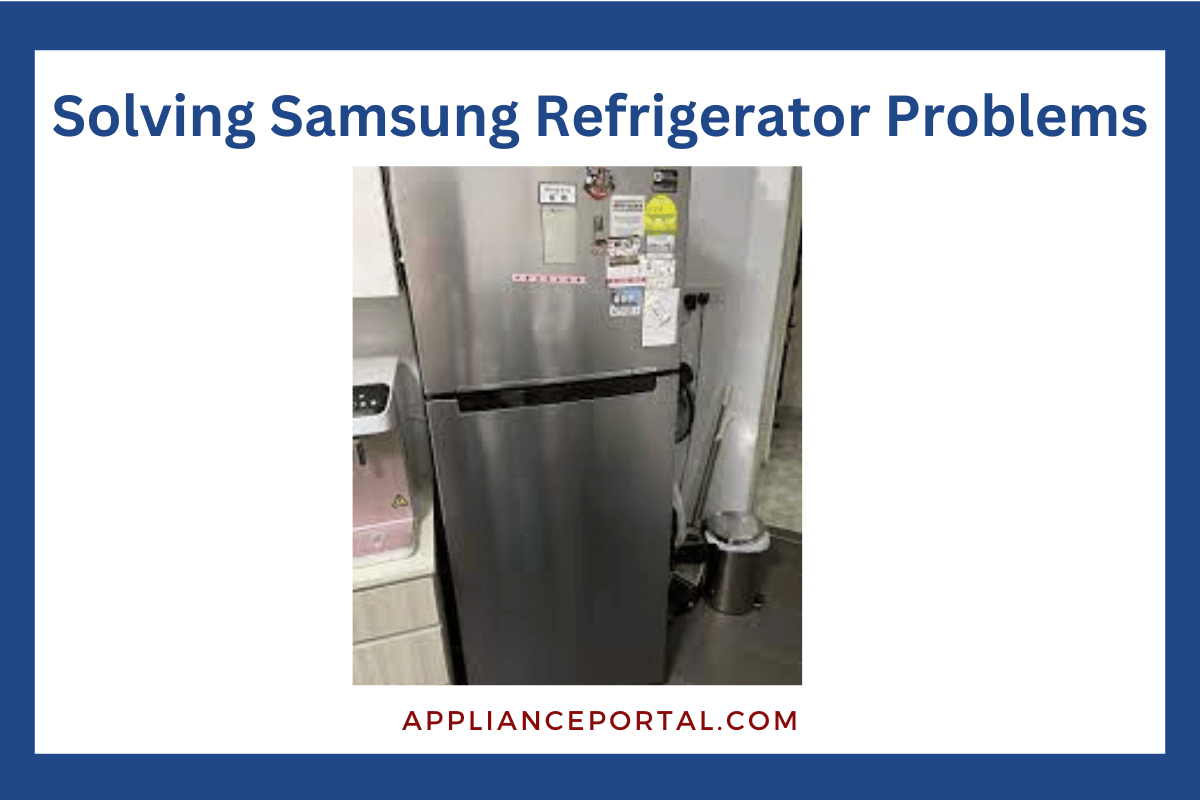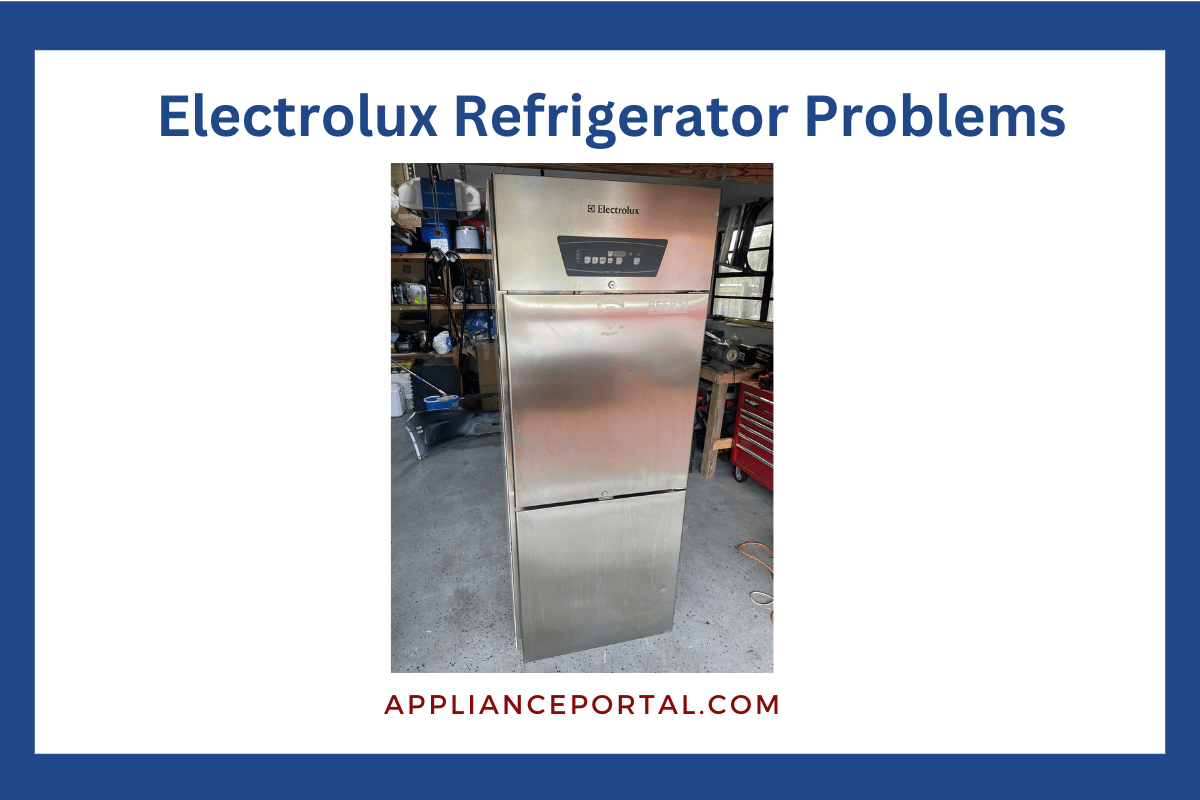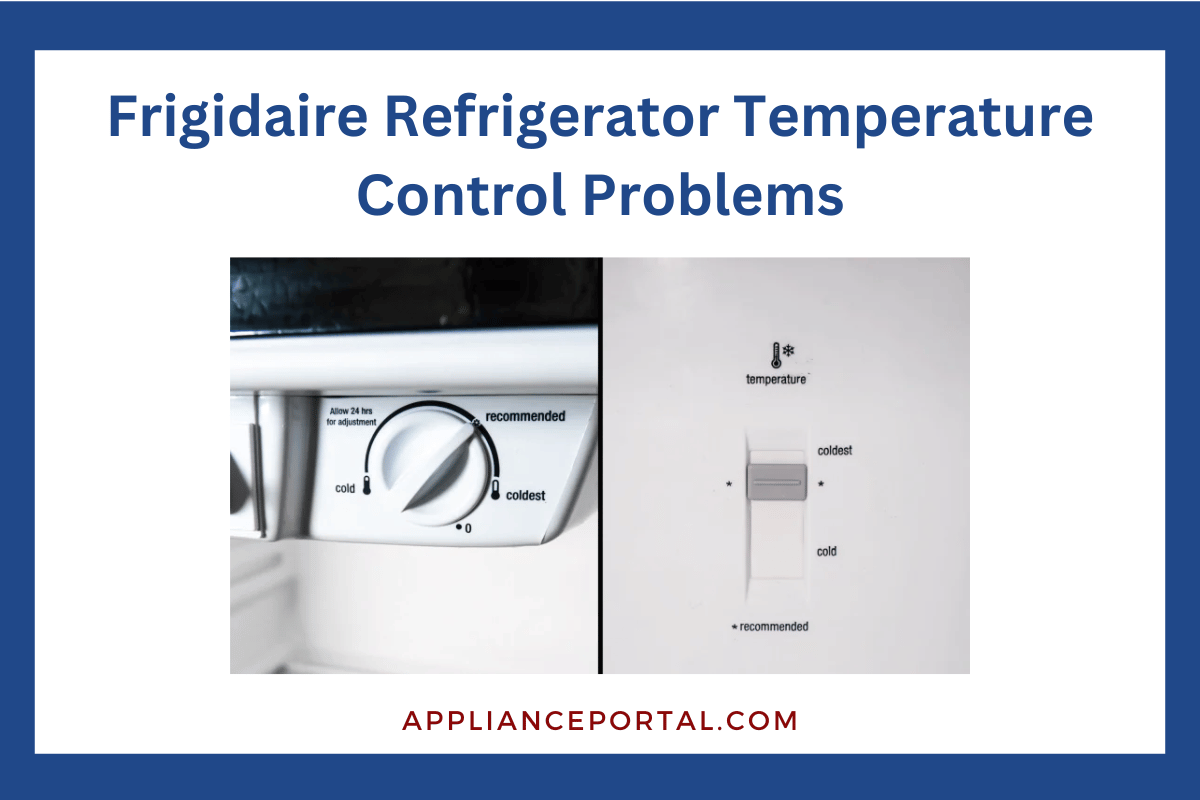The common problems with Samsung fridges include malfunction of the crushed-ice maker, water leakage, and asymmetrical doors. These issues can cause inconvenience and affect the proper functioning of the refrigerator.
Troubleshooting these problems is necessary to ensure the fridge operates smoothly and efficiently. We will discuss seven Samsung refrigerator problems and provide effective solutions to help resolve these issues. By following these troubleshooting steps, you can potentially save on repair costs and keep your Samsung fridge in optimal condition.
Let’s dive into the common problems and how to address them.
Common Samsung Refrigerator Problems
Common Samsung refrigerator problems include malfunctioning ice makers, water leakage issues, and asymmetrical doors. These problems can disrupt the functionality and convenience of the refrigerator.
:
Leaking:
- Water leaking from the refrigerator can be caused by a clogged drain pan. Inspect the drain pan for any blockages and clean it if necessary.
- Another common cause of leaking is a faulty drain clip. Replace the old drain clip with an upgraded one (DA61-06796A) to prevent water leakage.
- If the leak is coming from the evaporator panel, it may be due to a frozen drain. Remove the evaporator panel and thaw it to resolve the issue.
- Installing foil tape in the drain pan can also help prevent future leaks.
Noisy operation:
- If your Samsung refrigerator is making excessive noise, it could be due to a faulty evaporator fan or condenser fan. Inspect the fans for any damage or obstruction and replace if necessary.
- Another possible cause of noise is oxidation in the wire harnesses. Check the wire harnesses for any signs of oxidation and clean or replace them to eliminate the noise.
- Cleaning the condenser coils can also help reduce noise by improving the overall efficiency of the refrigerator.
Not cooling:
- If your Samsung refrigerator is not cooling properly, check the condenser coils for dirt and debris. Cleaning the coils can improve cooling performance.
- A malfunctioning control board can also cause cooling issues. Test the control board and replace it if needed.
- Additionally, a faulty compressor can lead to inadequate cooling. Inspect the compressor for any signs of damage and consider replacing it if necessary.
Ice maker issues:
- If your Samsung refrigerator’s ice maker is not working, start by removing the ice maker and inspecting it for any damage. Replace the ice maker if needed.
- Manually defrosting the refrigerator can often solve ice maker problems by clearing any ice build-up.
- Check the wire harness connected to the ice maker for any loose or damaged connections and repair as necessary.
Freezing:
- If your Samsung refrigerator is freezing food in the fridge section, a faulty defrost sensor could be the culprit. Test the defrost sensor and replace if necessary.
- Another common cause of freezing is an inadequate airflow. Inspect the fan and ensure it is functioning properly to prevent freezing issues.
- Installing a secondary heater can help remove ice from the fan and cabinet, improving the fridge’s overall performance.
Remember, regular maintenance and timely repairs can help prevent and resolve common problems with Samsung refrigerators.
Troubleshooting Tips For Samsung Refrigerator Problems
Experience troubleshooting tips for common Samsung refrigerator problems like malfunctioning ice makers, water leakage, and asymmetrical doors. Learn how to remove shelves, thaw frozen evaporator panels, and test sensors for a DIY solution to your fridge issues.
Removing And Cleaning The Shelves Of A Samsung Refrigerator:
- Carefully remove the shelves from your Samsung refrigerator.
- Use warm, soapy water to clean the shelves thoroughly.
- Rinse them with clean water and dry them before putting them back in place.
Thawing The Evaporator Panel If Frozen Shut:
- Unplug the refrigerator and open the freezer door.
- Remove any items blocking the evaporator panel.
- Use a hairdryer on a low heat setting to thaw the ice buildup on the panel.
Putting A Samsung Refrigerator In Forced Defrost Mode:
- Turn off the power to the refrigerator.
- Press and hold the Power Freeze and Fridge buttons simultaneously.
- Hold for about 8 seconds until the display goes off and the refrigerator beeps.
- The refrigerator is now in forced defrost mode.
Inspecting And Cleaning The Evaporator Coils:
- Unplug the refrigerator and remove the evaporator panel.
- Check the evaporator coils for any dirt, dust, or debris buildup.
- Gently clean the coils with a soft brush or vacuum cleaner attachment.
Repairing The Evaporator Panel:
- If the evaporator panel is damaged or broken, it may need to be replaced.
- Contact a professional technician for assistance with repairing or replacing the panel.
Dealing With Clogged Drain Pan Causing Water Leakage:
- Locate the drain pan at the bottom of the refrigerator.
- Check for any clogs or blockages in the drain pan.
- Use a pipe cleaner or wire to clear any debris from the drain hole.
Installing Foil Tape In The Drain Pan And Removing Old Drain Clips:
- Cut a piece of foil tape to fit the inside of the drain pan.
- Remove any old, worn-out drain clips from the pan.
- Apply the foil tape to the bottom of the drain pan to prevent future clogs.
Upgrading Drain Clip To Prevent Future Clogging:
- Replace the old drain clips with new, upgraded clips.
- These clips are designed to prevent debris from entering the drain hole.
Installing A Second Heater To Remove Ice From Fan And Cabinet:
- Consult a professional technician to install a second heater in your refrigerator.
- This additional heater helps prevent ice buildup on the fan and cabinet.
Replacing And Testing The Defrost Sensor:
- Unplug the refrigerator and locate the defrost sensor.
- Remove the old sensor and replace it with a new one.
- Test the new sensor to ensure it is functioning properly.
Inspecting Wire Harnesses For Oxidation:
- Check the wire harnesses in your refrigerator for any signs of oxidation.
- If you notice any corrosion or damage, replace the affected wire harnesses.
Installing Secondary Heater Power:
- Contact a professional technician to install secondary heater power in your refrigerator.
- This additional power source helps prevent ice buildup and ensures proper defrosting.
Testing The Secondary Heater:
- Once the secondary heater power is installed, test it to ensure it is functioning correctly.
- Contact a professional technician to perform this test if needed.
Cleaning Condenser Coils And Installing A Drain Tube:
- Unplug the refrigerator and locate the condenser coils at the back.
- Use a vacuum cleaner or a brush to clean the coils from any dirt or debris.
- Install a new drain tube if the old one is damaged or clogged.
Re-Installing The Evaporator Panel And Shelves:
- After completing the necessary repairs and cleaning, re-install the evaporator panel.
- Make sure it is securely in place.
- Put the shelves back in their original positions, ensuring they are stable and level.
Fixing A Samsung Refrigerator Freezer That Isn’T Working Or Won’T Cool
Fixing a Samsung refrigerator freezer that isn’t working or won’t cool is a common issue. Learn how to troubleshoot and resolve problems like a malfunctioning ice maker, water leakage, and temperature sensor issues to get your fridge back in working order.
If you’re experiencing issues with your Samsung refrigerator’s freezer not working or not cooling properly, there are several troubleshooting steps you can take to resolve the problem. From removing the ice maker to cleaning the condenser fan coils, here’s a step-by-step guide on how to fix a Samsung refrigerator freezer that isn’t working or won’t cool:
Removing The Ice Maker:
- Disconnect the power to the refrigerator.
- Locate the ice maker assembly and remove the screws or clips holding it in place.
- Gently pull the ice maker towards you to detach it from the refrigerator.
- Carefully disconnect the wire harness from the ice maker.
Manually Defrosting The Refrigerator:
- Turn off the refrigerator and remove all food items from the freezer.
- Leave the freezer door open and allow the ice to melt naturally. Use towels or a shallow pan to collect any water that drips.
- Once all the ice has melted, clean and dry the interior of the freezer before closing the door.
Removing The Wire Harness:
- Locate the wire harness in the freezer and carefully disconnect it.
- Inspect the wire harness for any signs of damage or corrosion.
- Clean the wire harness connectors with a toothbrush and rubbing alcohol if necessary.
- Reconnect the wire harness securely.
Temperature Sensor Test:
- Locate the temperature sensor inside the freezer.
- Use a multimeter to test the resistance of the temperature sensor.
- Compare the reading to the manufacturer’s specifications to determine if the sensor is functioning correctly.
- Replace the temperature sensor if it is faulty.
Reinserting The Ice Maker:
- Reconnect the wire harness to the ice maker.
- Position the ice maker back into place in the freezer.
- Secure the ice maker using screws or clips.
- Reconnect the power to the refrigerator.
Reinstalling Drawers In The Freezer:
- If you had to remove any drawers during the troubleshooting process, make sure they are clean and dry.
- Align the drawer with the tracks in the freezer and slide it in until it is fully seated.
- Repeat the steps for any additional drawers or bins that were removed.
Cleaning Condenser Fan Coils:
- Locate the condenser fan coils at the back of the refrigerator.
- Use a soft brush or vacuum cleaner with a brush attachment to remove any dust or debris from the coils.
- Ensure that the condenser fan is spinning freely and doesn’t have any obstructions.
Checking Pcb And Inverter Assembly:
- Consult the user manual or manufacturer’s instructions on how to access the PCB and inverter assembly.
- Inspect the PCB and inverter assembly for any visible damage or loose connections.
- Tighten any loose connections and replace any damaged components if necessary.
By following these troubleshooting steps, you can potentially fix a Samsung refrigerator freezer that isn’t working or won’t cool. However, if the problem persists, it is recommended to contact a professional technician or Samsung customer support for further assistance.

Credit: www.bobvila.com
Top 3 Common Issues In Samsung Fridges
The top 3 common issues in Samsung fridges include malfunction of the crushed-ice maker, water leakage, and asymmetrical doors.
Drain System Issues:
- The drain system in Samsung fridges can sometimes cause problems, leading to water leakage. This can occur due to a clogged drain line or a frozen drain.
- Some common signs of drain system issues include water pooling at the bottom of the fridge or leaking onto the floor.
- To troubleshoot and fix drain system problems in Samsung fridges, you can try the following steps:
- Check the drain line for any blockages or debris. Clear any obstructions using a pipe cleaner or a small brush.
- Defrost the drain line if it’s frozen. Use a hairdryer or hot water to thaw the ice buildup.
- Install foil tape in the drain pan to prevent water leakage.
- Consider replacing the old drain clip with an upgraded one (DA61-06796A) for better drainage.
Ice Maker Problems:
- Another common issue in Samsung fridges is ice maker problems. This can manifest in various ways, such as the ice maker not producing ice, producing small or misshapen ice cubes, or getting jammed.
- Some troubleshooting steps for ice maker problems in Samsung fridges include:
- Checking the water supply line for any kinks or blockages. Clear any obstructions to ensure proper water flow.
- Inspect the ice maker unit for any ice buildup or foreign objects. Clean the ice maker thoroughly.
- Manually defrost the refrigerator to remove any ice or frost that may be affecting the ice maker’s performance.
- If the issue persists, consider replacing the ice maker with a new one.
Defective Control Board Or Compressor:
- A defective control board or compressor can cause significant problems in Samsung fridges. These components are responsible for regulating temperature, initiating cooling cycles, and controlling the overall functionality of the refrigerator.
- Signs of a faulty control board or compressor in Samsung fridges may include inconsistent temperature, frequent cycling on and off, or complete loss of cooling.
- Troubleshooting and resolving control board or compressor issues in Samsung fridges may require professional assistance. It’s recommended to contact a certified technician for diagnosis and repair.
- Depending on the severity of the problem, the control board or compressor may need to be replaced to restore the fridge’s proper functioning.
Remember, if you experience any of these common issues in your Samsung fridge, it’s best to consult the manufacturer’s manual or seek professional help for accurate diagnosis and repair.
Frequently Asked Questions For Samsung Refrigerator Problems
What Is The Common Problem With Samsung Fridge?
The most common problems with Samsung fridges are malfunctioning ice makers, water leakage, and asymmetrical doors.
Is There A Recall On My Samsung Refrigerator?
Currently, I have not found any information regarding a recall on Samsung refrigerators.
Which Samsung Refrigerators Are In The Lawsuit?
Some Samsung refrigerators involved in the lawsuit include Samsung RF28T5001, Samsung RF28R7201, Samsung RF27T5501S, and Samsung RS25H5111.
What Is The Problem With The French Door Refrigerator?
The common problems with French door refrigerators include malfunctioning ice makers, water leakage, and asymmetrical doors.
Conclusion
Samsung refrigerators, like any other brand, can experience common issues that may affect their performance. These problems include malfunctions of the crushed-ice maker, water leakage, and asymmetrical doors. However, it’s important to note that these issues can be easily addressed and resolved with proper troubleshooting and maintenance.
By following the steps outlined in this blog post, such as manually defrosting the refrigerator, cleaning the condenser coils, and checking the drain system, users can effectively tackle these problems. Additionally, seeking professional help from appliance repair services is always an option for more complex issues.
Taking proactive measures to address and prevent these problems will ensure the longevity and optimal functioning of your Samsung refrigerator. Remember, regular maintenance and troubleshooting can help you enjoy a hassle-free refrigeration experience for years to come.





Leave a Reply